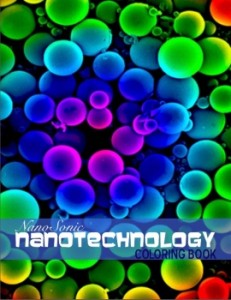Apparently, NASA (US National Aeronautics and Space Administration) supplied part of the funding for NanoSonic‘s children’s colouring book. The May 2, 2012 news item on Nanowerk provides this information,
NanoSonic developed a free nanotechnology coloring book to provide teachers with a resource for helping young students better understand the world of nanotechnology. This coloring book contains pictures and text related to nanotechnology on about a US fifth grade science and math level. Most of the images appear as abstract art. Students can let their imaginations run wild because most images of the nano world are taken with an electron microscope in black-and-white; researchers then apply their own colors to make them interesting and show special features.
NanoSonic’s April 19, 2012 press release offers some detail about the colouring book,
What does nylon fiber look like when you zoom in with an electron microscope? Or spider spinnerets – those things on a spider’s belly that allow it to create a web? Or the tip of the electron microscope itself? …
…
For example, the cover of the coloring book (…) was created from a Scanning Electron Microscope (SEM) photograph shot by Lee Williams of NanoSonic. It was then colored imaginatively by Sally Green who also added a title.
The first such SEM image was taken in 1935. SEMs are so powerful that they can magnify an object from ten to 500,000 times! Specimens are photographed in a vacuum, and they have to be completely dust- and debris-free. Basically, an SEM uses an electron beam to “trace” the sample surface, providing a three-dimensional view of the object – similar to the way a blind person might run their fingers over raised dots to read Braille.
Here’s an image of the front cover from the colouring book,
The colouring book has been vetted by teachers (from the May 2, 2012 news item),
This coloring book was funded in part by NASA. It was designed by Robin Rogers, Andrew Teates and Sally Green of NanoSonic, Inc. It was reviewed by Virginia public school teachers Brandi Smith of Macy McClaugherty Elementary/Middle School in Giles County and Susan Mauney of Blacksburg Middle School in Montgomery County.
As for NanoSonic, the company is a commercial enterprise that is not focused on the education sector, from the About NanoSonic webpage,
Nanosonic specializes in the design and manufacture of innovative materials, especially new materials that are currently unavailable in the commercial market. We develop revolutionary new molecular self-assembly processes that allow the controlled synthesis of material structure at the nanometer level. We also manufacture new materials that are designed with novel and useful engineering constitutive behaviors. Most of our materials are developed using a process that is environmentally benign.
NanoSonic has exclusively licensed patents covering electrostatic self-assembly (ESA) processing and use from Virginia Tech, the state’s leading research university. We have also established an intellectual property portfolio to enable process, material and device commercialization, as well as created a “library” of such self-assembled materials.
Our award-winning, high-tech company was founded by Richard Claus, Ph.D., an expert in advanced materials and structures who won the Optical Engineering Society’s Lifetime Achievement Award in 2002. In 2006, NanoSonic was ranked as the overall leader in a 13-state study of the strength of the nanotechnology industry. With 18 patents granted, we were also named to NASA’s Nano50.
NanoSonic’s staff is comprised of more than 70 research scientists, engineers, chemists, designers and fabricators. We work with all different sizes and types of companies and organizations, and clients include NASA, the U.S. Department of Defense and the National Science Foundation. Our work covers the entire range of product development from research through design and development to manufacturing and then commercialization of products such as nanomaterials, sensors and systems.
I would imagine the company’s founder, Richard Claus, was teased mightily as a child and still gets the occasional comment. Especially now that his company has produced a colouring book for children.
These kinds of projects always turn on an interesting problem. Do you have experts in the field (e.g. NanoSonic) develop and manage the project (colouring book) then bring in artistic and education expertise or do you have the artists or educators develop and manage the project then bring in the rest? There are no definitive answers as either way can work well. I also notice that NanoSonic has a number of resources that can be found by clicking on the Home page navigation bar’s Education menu item.
You can download the colouring book from here. There is also a Nanotechnology Coloring Book ANSWERS Sheet (pdf, 581 kb). Or you can go to the Nanotechnology Coloring Book page on the company website to access the downloads and more resources.
